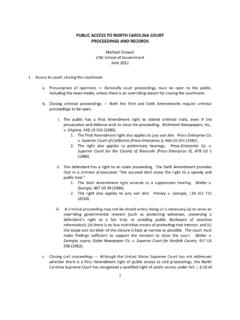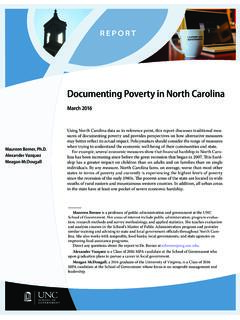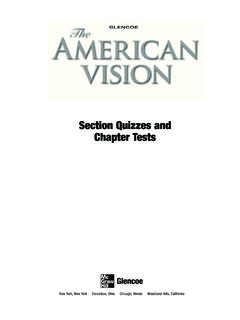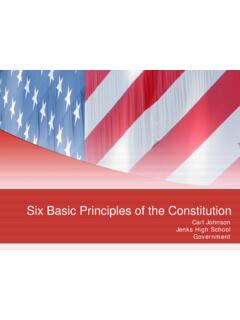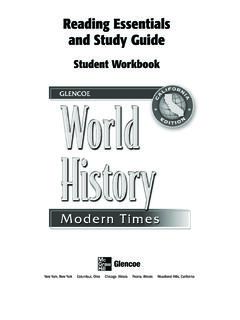Transcription of Examination, Cross-Examination, and Redirect Examination
1 1 Examination , Cross- Examination , and Redirect Examination Penny J. White I. Introduction: Duty to Exercise Control Rule 611 II. Specific Limitations on Witness Examinations A. Direct Examination Scope and Limitations B. Cross- Examination Scope and Limitations C. Use of Leading Questions D. Redirect and Recross Examination Scope and Limitations III. Specific Applications A. Refreshing Recollection vs. Past Recollection Recorded B. Prior Inconsistent Statements to Impeach vs. Prior Inconsistent Statements as Substantive Evidence C. Rule of Completeness vs. Concept of Opening the Door D. Right to Present a Defense E. Control Exercised Under Rule 611 vs. Limitation of Right to Cross-Exam IV. Objections Based on Ethical Issues V. Resources Kenneth S. Broun, BRANDIS & BROUN ON NORTH CAROLINA EVIDENCE 150 - 178 (referred to herein as Broun, at __) Robert L. Farb, Opening the Door for Admission of Evidence NORTH CAROLINA PROSECUTOR S MANUAL (4th ed.)
2 2007) Judge John W. Smith, Jury Arguments: Outline of the law or Discretion in Quick-Sand ( ) I. Introduction: Duty to Exercise Control Rule 611 Rule 611 is the starting point for analyzing objections based on the form of the question and the scope of direct, cross, and Redirect Examination . The rule supplements, but does not override, statutes that establish procedure for the order and presentation of evidence. Under Rule 611 a trial judge is required to exercise reasonable control over the mode and order of witness interrogation and evidence presentation. Like the overriding purpose of the rules of evidence, the purpose of the trial judge s duty to exercise control is to further the interests of truth and justice in a fair and efficient proceeding. 2 Specifically, the rule provides that order and control shall be exercised for three purposes: to (1) make the interrogation and presentation effective for the ascertainment of the truth, (2) avoid needless consumption of time, and (3) protect witnesses from harassment or undue embarrassment.
3 The case law offers numerous examples of trial judge s exercising appropriate control to accomplish these three scope of cross- Examination is intentionally broad. Rule 611(b) allows cross- Examination on any matter relevant to any issue in the case, including credibility. The North Carolina courts have consistently held that cross- Examination may serve four purposes: to expand on the details offered on direct Examination ; to develop new or The broad duty to exercise control requires the judge to decide numerous questions that arise during the course of a trial which can be solved only by the judge s common sense and fairness in view of the particular circumstances. Advisory Committee Notes, Fed. R. Evid. 611 (containing contents identical to Evid. 611). The manner by which the trial judges exercises control over the presentation of evidence rests primarily within the judge s discretion.
4 These decisions will not be disturbed absent a manifest abuse of discretion. State v. Harris, 315 556, 562 (1986). Thus, a judge, exercising sound discretion, may, among other things, control the order in which witnesses are called and depart from the regular order of proof to allow witnesses to be recalled and cases to be reopened. See Huddleston v. United States, 485 681, 690 (1988)( the trial court has traditionally exercised the broadest sort of discretion in controlling the order of proof at trial .. ). But, a party has no right to these departures. II. Specific Limitations on Witness Examination A. Direct Examination Scope and Limitations Rule 611 requires the trial judge to exercise reasonable control over witness interrogation and evidence presentation. This broad duty covers issues related to the form of the question asked on direct. Courts have discretion to limit questions that call for a narrative, leading questions on direct Examination , and cumulative evidence.
5 The use of leading questions is discussed below. B. Cross- Examination Scope and Limitations Subsections (b) and (c) of Rule 611 specifically address two issues related to the presentation of evidence the scope of cross- Examination and the use of leading questions. Both subsections establish limits within which a trial judge should exercise discretion in maintaining control and order. 1 See, , State v. Johnston, 344 596 (1996)(disallowing repetitive questions); State v. Jaynes, 342 249 (1995)(limiting repetitious questions); State v. Cook, 280 642 (1972)(prohibiting repetitious answer). 3 different facts relevant to the case; to impeach the witness; or to raise issues about a witness credibility. Thus, when an objection is made that a question exceeds the permissible scope of cross- Examination , the trial judge must overrule the objection if the question is relevant to any issue in the case, including credibility.
6 Many decisions illustrate the broad scope of the cross-exam, but perhaps few better than the recent decision of State v. Whaley, 362 156 (2008) in which the North Carolina Supreme Court reversed a conviction based upon limitations imposed on cross- Examination of the victim. The defense sought to cross-examine the victim about her answers to a questionnaire completed during a visit to a counseling center. The defense argued that the evidence was relevant to the issue of the victim s credibility. The trial court excluded the evidence based on the absence of proof that the victim suffered from a mental defect and under Rule 403. In reversing the decision, the Supreme Court emphasized the broad scope of cross- Examination , the importance of the testimony on the key issue in the case, and the presence of contradictory evidence. Although there was no evidence that the witness suffered from a mental defect, the Supreme Court reasoned that the questions might produce answers that bear upon credibility in other ways, such as to cast doubt upon the capacity of a witness to observe, recollect, and recount.
7 Id. at 161 (quoting State v. Williams, 330 711, 719 (1992). Excluding the cross- Examination .. had the effect of largely depriving defendant of [her] major defense. Id. (quoting Williams, at 721-22). C. Use of Leading Questions Rule 611(c) addresses the use of leading questions. As Professor Broun notes a leading question is generally one that suggests the answer. Broun, at 169. The prohibition on leading questions is based on fairness and the desire that the witness, not counsel, supply the answer to a question. Rule 611 (c) provides that leading questions should not be used on the direct Examination of a witness except as may be necessary to develop [the] testimony. Examples of situations in which leading questions are allowed to develop a witness testimony include (1) questions that direct or Redirect a witness attention to a specific matter; (2) questions posed to a witness who demonstrates difficulty in understanding; (3) questions about sensitive or delicate matters; (4) questions that assist a witness in recollecting; (5) questions asked to contradict another witness testimony; (6) questions regarding preliminary matters; and (7) questions about matters that are not in dispute.)
8 Subsection (c) also provides that leading questions ordinarily .. should be permitted on cross- Examination . While this rule is consistent with the general trial practice principle that all questions on cross- Examination should be leading, the rule preserves some discretion for the trial judge to limit leading questions in extraordinary situations consistent with the trial judge s general duty under Rule 611(a). The rule permits a trial judge to limit leading questions in extraordinary situations, but a trial judge 4 may not limit cross- Examination . The North Carolina Supreme Court has recognized that the right to cross-examine is absolute and not merely a privilege, and that its denial is prejudicial and fatal error. See State v. Short, 322 783, 791(1988)(quoting Citizens Bank & Trust v. Reid Motor Co., 216 432, 434 (1939)). In addition, the right to cross- Examination is an essential element of a defendant s constitutional right under the Sixth Amendment to the United States constitution .
9 Crawford v. Washington, 541 36 (2004). In addition to the general provision regarding the use of leading questions on cross- Examination , Rule 611(c) allows the use of leading questions [w]hen a party calls a hostile witness, an adverse party, or a witness identified with an adverse party. Whether a witness is hostile or identified with an adverse party is a threshold matter for the trial judge to determine under Rule 104. D. Redirect and Recross Examination Redirect and recross Examination are also subject to control by the trial judge. Redirect is for the purpose of clarifying the direct Examination and addressing issues raised on cross- Examination ; counsel is not entitled to repeat matters or bring out new matters on Redirect Examination . The trial judge may allow exceptions to this limitation if the circumstances require. If the trial judge allows counsel to elicit new matters on Redirect , recross should be allowed, but otherwise, the trial judge, in the exercise of reasonable discretion, may disallow a second cross- Examination .
10 See generally State v. Cummings, 352 600 (2000); see also United States v. Riggi, 951 1368, 1375 (3d Cir. 1991)(suggesting that denying recross if new matters are raised on Redirect would violate Confrontation Clause). Fairness may necessitate an opportunity for Redirect or recross Examination . As explained by the North Carolina Supreme Court more than a century ago: A party cannot be allowed to impeach a witness on the cross- Examination by calling out evidence culpatory of himself and there stop, leaving the opposing party without opportunity to have the witness explain his conduct, and thus place it in an unobjectionable light if he can. In such case the opposing party has the right to such explanation, even though it may affect adversely the party who cross examined. Upon the Examination in chief, the evidence may not be competent, but the cross- Examination may make it so.

